 | | | Switch to: Europe, USA, New Zealand, Antarctica Credit: NOAA/Ovation  Planetary K-index Planetary K-index
Now: Kp= 6.33 storm
24-hr max: Kp= 7.00 strong
explanation | more data
Interplanetary Mag. Field
Btotal: 15.59 nT
Bz: -9.31 nT south
more data: ACE, DSCOVR
Updated: Today at 1146 UT  Coronal Holes: 05 Nov 23 Coronal Holes: 05 Nov 23 
Solar wind flowing from this coronal hole should reach Earth on Nov. 7-8. Credit: SDO/AIA  Noctilucent Clouds Noctilucent Clouds
The northern season for NLCs began on May 26th. The first clouds were detected inside the Arctic Circle by the NOAA 21 satellite. An instrument onboard NOAA 21 (OMPS LP) is able to detect NLCs (also known as "polar mesospheric clouds" or PMCs). For the rest of the season, daily maps from NOAA 21 will be presented here:
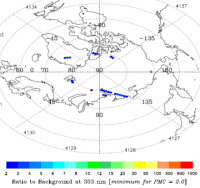
Updated: Aug. 29, 2023
Each dot is a detected cloud. As the season progresses, these dots will multiply in number and shift in hue from blue to red as the brightness of the clouds intensifies.
What happened to NASA's AIM spacecraft, which has been monitoring NLCs since 2007? Earlier this year, the spacecraft's battery failed. As a result AIM is offline, perhaps permanently. There may be some hope of a recovery as AIM's orbit precesses into full sunlight in 2024. Until then, we will maintain AIM's iconic "daily daisy," frozen at Feb. 28, 2023, as a show of thanks for years of service and hope for future daisies:  |  |  | Switch view:Ross Ice Shelf, Antarctic Peninsula, East Antarctica, Polar Updated Nov05  SPACE WEATHER
NOAA Forecasts | | Updated at: 2023 Nov 05 2200 UTC FLARE | 0-24 hr | 24-48 hr | CLASS M | 25 % | 25 % | CLASS X | 05 % | 05 % |  Geomagnetic Storms: Geomagnetic Storms:
Probabilities for significant disturbances in Earth's magnetic field are given for three activity levels: active, minor storm, severe storm Updated at: 2023 Nov 05 2200 UTC Mid-latitudes | 0-24 hr | 24-48 hr | ACTIVE | 30 % | 30 % | MINOR | 35 % | 15 % | SEVERE | 20 % | 01 % | High latitudes | 0-24 hr | 24-48 hr | ACTIVE | 10 % | 15 % | MINOR | 20 % | 20 % | SEVERE | 40 % | 20 % | | | |  | | | | | | | | | | | This is an AI Free Zone! Text created by ChatGPT and other Large Language Models is spreading rapidly across the Internet. It's well-written, artificial, frequently inaccurate. If you find a mistake on Spaceweather.com, rest assured it was made by a real human being. | | | UPDATE--THE STORM MAY BE SUBSIDING: A geomagnetic storm is still underway, but it may be subsiding. Storm levels have dropped from G3 to G2 as Earth begins to exit the wake of a CME that struck earlier today. There is still a chance of one more CME impact before the day is over, so aurora watchers should stay tuned. Full story below... CME IMPACT SPARKS STRONG GEOMAGNETIC STORM: A CME hit Earth's magnetic field on Nov. 5th at 0905 UT, sparking a strong G3-class geomagnetic storm. This could be the early arrival of a full-halo CME, which we warned readers about yesterday. But maybe not. We knew that another lesser CME was preceding the halo, and this could be it. If the full halo CME is still coming, it could intensify geomagnetic activity even more when it arrives later today. Stay tuned! CME alerts: SMS Text The CME impact sparked auroras in more than a dozen US states. Dan Bush sends this picture from Albany, Missouri (+40.2N): 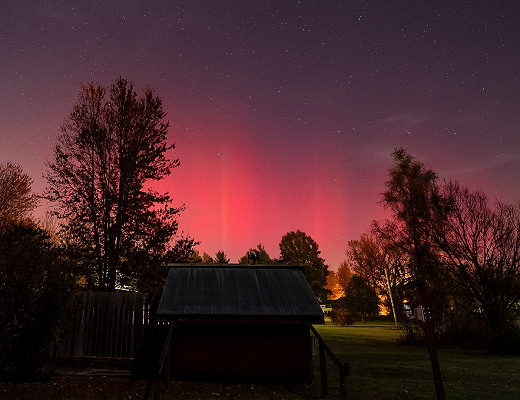
"This display lasted about 15-20 minutes," says Bush. "The red was intense enough that it was easily visible to the dark-adapted naked eye." Other reports of mid-latitude auroras have come from Colorado (+40.1N) and Kansas (+38.2). Simiar displays may be seen again tonight if the persists after nightfall. Meanwhile, inside the Arctic Circle, a rare display of naked-eye red auroras is in progress. "In 10 years plus of shooting aurora never seen anything like it," says Oliver Wright, a longtime guide for Lights over Lapland, who sends this picture from Abisko, Sweden: 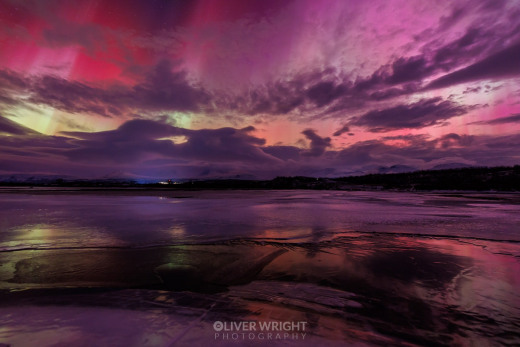
"I could not belive my eyes as the whole sky was blood red to the naked eye," says Wright. "Unbelievable!" Red auroras come from atomic oxygen in Earth's upper atmosphee shining at 6300 Å. The human eye is famously insensitive to this wavelength; it takes a strong geomagnetic storm (like today's) to make the red glow visible to the unaided eye. Realtime Aurora Photo Gallery
Free: Spaceweather.com Newsletter
AMBER DRAGONFLY SPACE PENDANT: This dragonfly has touched space. On Oct 31st, the students of Earth to Sky Calculus launched it to the stratosphere onboard a cosmic ray research balloon, 105,108 feet above California's Sierra Nevada: 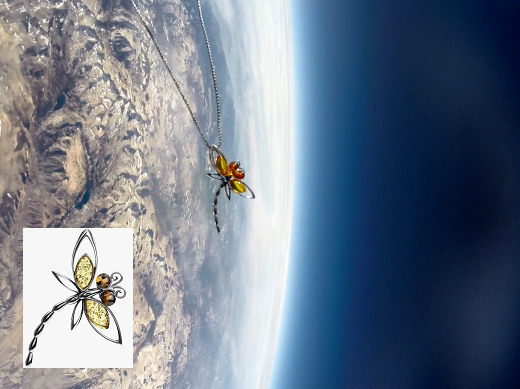
You can have it for $169.95. Made of genuine Baltic Amber with a sterling silver exoskeleton, the rich Cognac-colored pendant measures 3/4 inch and comes with a matching 18-inch sterling silver chain. The students are selling space pendants to pay the helium bill for their cosmic ray ballooning program. Each one comes with a greeting card showing the jewelry in flight and telling the story of its trip to the stratosphere and back again. Far Out Gifts: Earth to Sky Store
All sales support hands-on STEM education FALSE AURORAS: They look like auroras, but they're not. Dewey Vanderhoff photographed these colorful light pillars above Cody, Wyoming, on Oct. 28th: 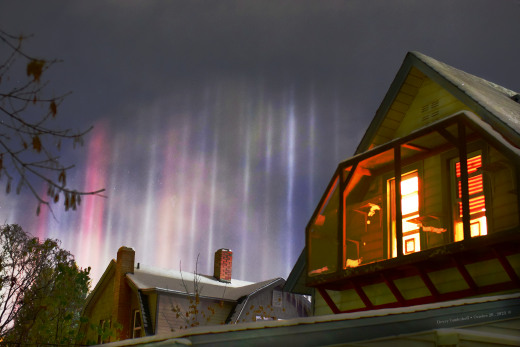
Like better-known sun pillars, light pillars are caused by plate-shaped ice crystals fluttering downward through the atmosphere. On cold autum nights, low-to-the-ground ice crystals can reflect and refract city lights to produce such aurora-like displays. It was only 5°F outside when Vanderhoff took the picture--a 5s exposure at ISO 1600. Realtime Space Weather Photo Gallery
Free: Spaceweather.com Newsletter
Realtime Aurora Photo Gallery
Free: Spaceweather.com Newsletter
Realtime Comet Photo Gallery
Free: Spaceweather.com Newsletter Every night, a network of NASA all-sky cameras scans the skies above the United States for meteoritic fireballs. Automated software maintained by NASA's Meteoroid Environment Office calculates their orbits, velocity, penetration depth in Earth's atmosphere and many other characteristics. Daily results are presented here on Spaceweather.com. On Nov 05, 2023, the network reported 9 fireballs.
(4 sporadics, 2 Northern Taurids, 2 Orionids, 1 November Draconid) 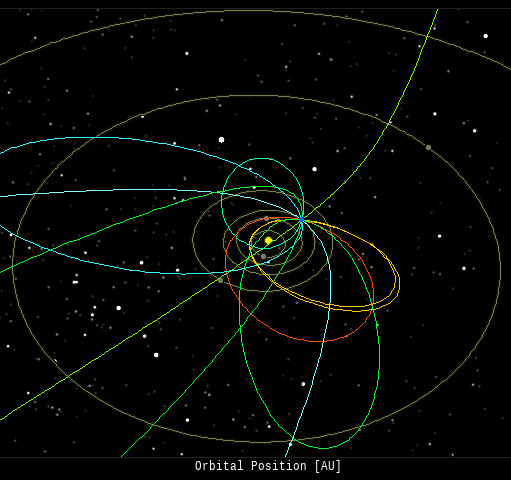 In this diagram of the inner solar system, all of the fireball orbits intersect at a single point--Earth. The orbits are color-coded by velocity, from slow (red) to fast (blue). [Larger image] [movies] Potentially Hazardous Asteroids ( PHAs) are space rocks larger than approximately 100m that can come closer to Earth than 0.05 AU. None of the known PHAs is on a collision course with our planet, although astronomers are finding new ones all the time. On November 5, 2023 there were 2349 potentially hazardous asteroids.
 | Recent & Upcoming Earth-asteroid encounters: | Asteroid | Date(UT) | Miss Distance | Velocity (km/s) | Diameter (m) | | 2023 TW6 | 2023-Oct-31 | 19.2 LD | 24.4 | 91 | | 2023 VZ | 2023-Nov-01 | 2.6 LD | 19.6 | 15 | | 2023 VK | 2023-Nov-01 | 11.1 LD | 14 | 24 | | 2013 UV3 | 2023-Nov-01 | 14.7 LD | 15.4 | 15 | | 2004 VZ14 | 2023-Nov-01 | 3.5 LD | 15 | 31 | | 2023 UZ3 | 2023-Nov-01 | 2.7 LD | 14.4 | 19 | | 2023 VA | 2023-Nov-02 | 0.1 LD | 11.3 | 7 | | 2016 WY | 2023-Nov-02 | 9.1 LD | 3.9 | 5 | | 363505 | 2023-Nov-02 | 13.7 LD | 8 | 709 | | 2023 UY3 | 2023-Nov-02 | 14.1 LD | 3.7 | 15 | | 2023 VG | 2023-Nov-02 | 0.3 LD | 8.5 | 8 | | 2022 JF | 2023-Nov-03 | 15.2 LD | 17.2 | 39 | | 2023 VJ | 2023-Nov-03 | 9.7 LD | 16.5 | 29 | | 2023 QP8 | 2023-Nov-03 | 17.1 LD | 8.8 | 180 | | 2016 VW2 | 2023-Nov-03 | 10.1 LD | 8.1 | 20 | | 2019 UH7 | 2023-Nov-04 | 9.9 LD | 5.9 | 11 | | 2023 VE1 | 2023-Nov-04 | 0.1 LD | 6.5 | 3 | | 2023 TL31 | 2023-Nov-04 | 8.1 LD | 9.2 | 28 | | 2023 VU | 2023-Nov-05 | 2.6 LD | 14.4 | 21 | | 2023 UG4 | 2023-Nov-06 | 6.5 LD | 3.5 | 18 | | 2023 VG1 | 2023-Nov-06 | 7.9 LD | 10.3 | 12 | | 2023 TO15 | 2023-Nov-06 | 15.2 LD | 11.2 | 49 | | 2023 VS | 2023-Nov-07 | 1 LD | 3.5 | 4 | | 2023 VE | 2023-Nov-07 | 3.1 LD | 12.1 | 11 | | 2023 VR | 2023-Nov-07 | 2.4 LD | 11.8 | 10 | | 2023 TD14 | 2023-Nov-08 | 9.3 LD | 6.3 | 24 | | 2023 VW | 2023-Nov-08 | 1.7 LD | 8 | 9 | | 2023 VC | 2023-Nov-09 | 6.3 LD | 9.6 | 31 | | 2023 VD1 | 2023-Nov-11 | 17.2 LD | 10 | 32 | | 2023 UQ4 | 2023-Nov-11 | 10.7 LD | 8.4 | 39 | | 2023 TZ2 | 2023-Nov-12 | 19 LD | 2.8 | 24 | | 2014 BA3 | 2023-Nov-13 | 15.7 LD | 2.7 | 8 | | 2023 VX | 2023-Nov-13 | 17.4 LD | 11.1 | 50 | | 2023 UO | 2023-Nov-15 | 6.4 LD | 6.8 | 38 | | 2021 TN3 | 2023-Nov-15 | 17 LD | 6.3 | 31 | | 2019 VL5 | 2023-Nov-16 | 8.5 LD | 8.2 | 24 | | 2019 LB1 | 2023-Nov-18 | 15.8 LD | 4.2 | 14 | | 2016 DK1 | 2023-Nov-19 | 5.3 LD | 6.8 | 12 | | 2022 VR1 | 2023-Nov-19 | 8.1 LD | 6.1 | 39 | | 2019 UT6 | 2023-Nov-24 | 9 LD | 13.2 | 141 | | 2019 CZ2 | 2023-Nov-25 | 2.8 LD | 5.8 | 44 | | 2013 UB3 | 2023-Nov-27 | 18.5 LD | 5.4 | 25 | | 1998 WB2 | 2023-Dec-03 | 11 LD | 14.2 | 151 | | 2013 VX4 | 2023-Dec-04 | 5.1 LD | 6.6 | 60 | | 2023 TB27 | 2023-Dec-06 | 17 LD | 4.3 | 45 | | 139622 | 2023-Dec-06 | 14.4 LD | 6.7 | 719 | | 2020 HX3 | 2023-Dec-10 | 9.8 LD | 15.7 | 13 | | 2010 XF3 | 2023-Dec-11 | 19.4 LD | 4 | 46 | | 2016 XD2 | 2023-Dec-19 | 18.7 LD | 6.9 | 59 | | 341843 | 2023-Dec-20 | 16.5 LD | 5.3 | 344 | | 2018 YJ2 | 2023-Dec-21 | 18.4 LD | 13.1 | 154 | | 2022 YG | 2023-Dec-22 | 10.8 LD | 5.1 | 17 | | 2020 YO3 | 2023-Dec-23 | 3.6 LD | 16.6 | 42 | | 2010 UE51 | 2023-Dec-24 | 9 LD | 1.3 | 7 | | 2020 YR2 | 2023-Dec-25 | 13.8 LD | 8 | 8 | | 2021 AM6 | 2023-Dec-31 | 18.3 LD | 6.6 | 17 | | 2019 KK5 | 2024-Jan-03 | 10.6 LD | 20.9 | 98 | Notes: LD means "Lunar Distance." 1 LD = 384,401 km, the distance between Earth and the Moon. 1 LD also equals 0.00256 AU. | | Cosmic Rays in the Atmosphere | SPACE WEATHER BALLOON DATA: Almost once a week, Spaceweather.com and the students of Earth to Sky Calculus fly space weather balloons to the stratosphere over California. These balloons are equipped with sensors that detect secondary cosmic rays, a form of radiation from space that can penetrate all the way down to Earth's surface. Our monitoring program has been underway without interruption for 7 years, resulting in a unique dataset of in situ atmospheric measurements. Latest results (July 2022): Atmospheric radiation is decreasing in 2022. Our latest measurements in July 2022 registered a 6-year low: 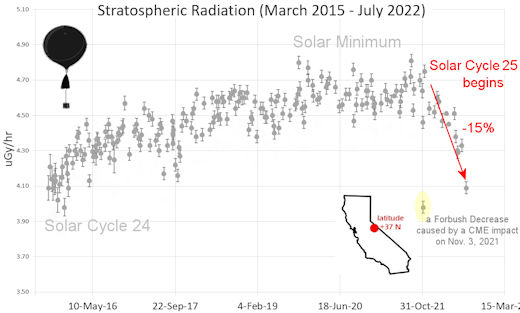
What's going on? Ironically, the radiation drop is caused by increasing solar activity. Solar Cycle 25 has roared to life faster than forecasters expected. The sun's strengthening and increasingly tangled magnetic field repels cosmic rays from deep space. In addition, solar coronal mass ejections (CMEs) sweep aside cosmic rays, causing sharp reductions called "Forbush Decreases." The two effects blend together to bring daily radiation levels down. .Who cares? Cosmic rays are a surprisingly "down to Earth" form of space weather. They can alter the chemistry of the atmosphere, trigger lightning, and penetrate commercial airplanes. According to a study from the Harvard T.H. Chan school of public health, crews of aircraft have higher rates of cancer than the general population. The researchers listed cosmic rays, irregular sleep habits, and chemical contaminants as leading risk factors. A number of controversial studies (#1, #2, #3, #4) go even further, linking cosmic rays with cardiac arrhythmias and sudden cardiac death. Technical notes: The radiation sensors onboard our helium balloons detect X-rays and gamma-rays in the energy range 10 keV to 20 MeV. These energies span the range of medical X-ray machines and airport security scanners. Data points in the graph labeled "Stratospheric Radiation" correspond to the peak of the Regener-Pfotzer maximum, which lies about 67,000 feet above central California. When cosmic rays crash into Earth's atmosphere, they produce a spray of secondary particles that is most intense at the entrance to the stratosphere. Physicists Eric Regener and Georg Pfotzer discovered the maximum using balloons in the 1930s and it is what we are measuring today. | | The official U.S. government space weather bureau | | | The first place to look for information about sundogs, pillars, rainbows and related phenomena. | | | Researchers call it a "Hubble for the sun." SDO is the most advanced solar observatory ever. | | | 3D views of the sun from NASA's Solar and Terrestrial Relations Observatory | | | Realtime and archival images of the Sun from SOHO. | | | information about sunspots based on the latest NOAA/USAF Active Region Summary | | | current counts of failed and deployed Starlink satellites from Jonathan's Space Page | | | Authoritative predictions of space junk and satellite re-entries | | | from the NOAA Space Environment Center | | | fun to read, but should be taken with a grain of salt! Forecasts looking ahead more than a few days are often wrong. | | | from the NOAA Space Environment Center | | | the underlying science of space weather |  | When looking for casinos to play online when the weather is bad, you can try casino online trucchi for Italian games. If you are not from Finland you can try the Swedish page Svenska casino online to find suitable games, check out svenskacasinoonline.net. Always check your local laws before playing with real money. |  | BestCSGOGambling is the best site for everything related to CSGO gambling on the web | | | These links help Spaceweather.com stay online. Thank you to our supporters! | | | | | | | | |  | |  |   | ©2021 Spaceweather.com. All rights reserved. This site is penned daily by Dr. Tony Phillips. | |

